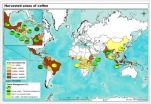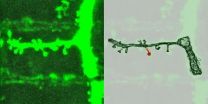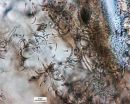(Press-News.org) The proportion of land used to cultivate shade grown coffee, relative to the total land area of coffee cultivation, has fallen by nearly 20 percent globally since 1996, according to a new study by scientists from The University of Texas at Austin and five other institutions.
The study's authors say the global shift toward a more intensive style of coffee farming is probably having a negative effect on the environment, communities and individual farmers.
"The paradox is that there is greater public interest than ever in environmentally friendly coffee, but where coffee production is expanding across the globe, it tends to be very intensive," says Shalene Jha, assistant professor in The University of Texas at Austin's College of Natural Sciences and lead author of the study published April 16 in the journal Bioscience.
Traditional shade grown coffee is cultivated under a diverse canopy of native forest trees in dense to moderate shade. Though some of the forest understory is cleared for farming, a rich web of plant and animal life remains. As a result, shade grown coffee plantations provide corridors for migrating birds to move between forest fragments, attract and support economically valuable pollinators such as bees and bats, and provide ecosystem services such as filtering water and air, stabilizing soil during heavy rains, storing carbon and replenishing soil nutrients.
In this latest study, the researchers found that total global production of shade grown coffee has increased since 1996, but the area of land used for non shade coffee has increased at a much faster rate, resulting in shade grown coffee falling from 43 percent of total cultivated area to 24 percent.
"We were surprised that despite two decades of growth in public awareness of where coffee comes from and the different ways to manage it for biodiversity, shade grown coffee only seems to be grown in a few regions," says Jha. "The shifts aren't what we would expect based on what we see on the shelves in the U.S."
In the United States, the market for specialty coffee, which includes organic and shade grown varieties, has grown rapidly during the past decade. Across most U.S. distributors, sales of specialty coffee rose more than 75 percent by economic value from 2000 to 2008. In 2012, specialty coffees accounted for 37 percent of U.S. coffee sales by volume and nearly half by economic value, an estimated $30 billion to $32 billion.
The study also found that since 1990, the land area under coffee cultivation has contracted in Africa and expanded in Asia. Within Asia, Vietnam and Indonesia have had the largest increases in coffee production during that time. Most of the new production is done in an intensive style.
This more intensive style is characterized by clearing forests or pasture for cultivation, increasing the density of plantings and switching to a variety of coffee called Robusta that tolerates full sun. Robusta is a lower-quality coffee than the other major variety sold around the world, Arabica. The two strains are often blended to produce instant coffee.
Jha and colleagues say the shifting trends toward Asia and a more intensive style of farming are driven by a dramatic drop in global coffee prices in recent years. To remain profitable, some growers have moved, seeking lower land and labor costs and higher short-term yields.
But there are hidden costs to this more intensive style. Full sun coffee plantations often result in deforestation, loss of biodiversity and soil depletion while leaving communities more vulnerable to flooding and landslides.
"Intensive coffee production is not sustainable," says Jha. "You exhaust the soil and after a couple of decades, it can no longer grow coffee. On the other hand, the oldest coffee farms in the world have thrived for centuries because the forest replenishes the soil for them."
Farmers doing intensive coffee farming also earn lower prices for their product.
Because the up-front costs of getting certified to sell specialty coffees can be expensive, Jha and colleagues encourage government agencies, conservation groups and aid organizations to partner with farmers to develop strategies to get more farmers into shade grown coffee production.
Some of the data used in this study came from the United Nations Food and Agriculture Organization and from interviews with coffee authorities, government agencies and private corporations.
INFORMATION:
Jha's co-authors are Christopher Bacon (Department of Environmental Studies and Sciences, Santa Clara University), Stacy Philpott (University of California, Santa Cruz), V. Ernesto Méndez (University of Vermont), Peter Läderach (International Center for Tropical Agriculture, Nicaragua) and Robert Rice (Migratory Bird Center at the Smithsonian Conservation Biology Institute).
Shade grown coffee shrinking as a proportion of global coffee production
2014-04-16
ELSE PRESS RELEASES FROM THIS DATE:
Synapses -- stability in transformation
2014-04-16
This news release is available in German. Synapses are the points of contact at which information is transmitted between neurons. Without them, we would not be able to form thoughts or remember things. For memories to endure, synapses sometimes have to remain stable for very long periods. But how can a synapse last if its components have to be replaced regularly? Scientists from the Max Planck Institute of Neurobiology in Martinsried near Munich have taken a decisive step towards answering this question. They have succeeded in demonstrating that when a synapse is formed, ...
Scratching the surface: Microbial etchings in impact glass and the search for life on Mars
2014-04-16
Boulder, Colo., USA – Haley M. Sapers and colleagues provide what may be the first report of biological activity preserved in impact glass. Recent research has suggested that impact events create novel within-rock microbial habitats. In their paper, "Enigmatic tubular features in impact glass," Sapers and colleagues analyze tubular features in hydrothermally altered impact glass from the Ries Impact Structure, Germany, that are remarkably similar to the bioalteration textures observed in volcanic glasses.
The authors note that mineral-forming processes cannot easily ...
Cancer drugs block dementia-linked brain inflammation, UCI study finds
2014-04-16
Irvine, Calif., April 16, 2014 — A class of drugs developed to treat immune-related conditions and cancer – including one currently in clinical trials for glioblastoma and other tumors – eliminates neural inflammation associated with dementia-linked diseases and brain injuries, according to UC Irvine researchers.
In their study, assistant professor of neurobiology & behavior Kim Green and colleagues discovered that the drugs, which can be delivered orally, eradicated microglia, the primary immune cells of the brain. These cells exacerbate many neural diseases, including ...
Recycling industrial waste water
2014-04-16
A research group composed of Dr. Martin Prechtl, Leo Heim and their colleagues at the University of Cologne's Department of Chemistry has discovered a new method of generating hydrogen using water and formaldehyde. The generation of hydrogen from liquids is of particular interest when it comes to fuel cell technologies. The results of the project, entitled "Selective and mild hydrogen production using water and formaldehyde", have recently been published in the journal Nature Communications.
Among other applications, the new approach can be used to recycle industrial ...
Research uncovers DNA looping damage tied to HPV cancer
2014-04-16
It's long been known that certain strains of human papillomavirus (HPV) cause cancer. Now, researchers at The Ohio State University have determined a new way that HPV might spark cancer development – by disrupting the human DNA sequence with repeating loops when the virus is inserted into host-cell DNA as it replicates.
Worldwide, HPV causes about 610,000 cases of cancer annually, accounting for about five percent of all cancer cases and virtually all cases of cervical cancer. Yet, the mechanisms behind the process aren't yet completely understood.
This study, recently ...
New type of barcode could make counterfeiters' lives more difficult
2014-04-16
Counterfeiters, beware! Scientists are reporting the development of a new type of inexpensive barcode that, when added to documents or currency, could foil attempts at making forgeries. Although the tags are easy for researchers to make, they still require ingredients you can't exactly find at the local hardware store. Their report appears in the Journal of the American Chemical Society.
Xiaogang Liu and colleagues explain that scientists have used fluorescent and DNA-based barcodes, or tags of known composition and sequence, in attempts to develop tests for cancer and ...
A greener source of polyester -- cork trees
2014-04-16
On the scale of earth-friendly materials, you'd be hard pressed to find two that are farther apart than polyester (not at all) and cork (very). In an unexpected twist, however, scientists are figuring out how to extract a natural, waterproof, antibacterial version of the first material from the latter. Their new technique, which could have applications in medical devices, appears in the ACS journal Biomacromolecules.
Cristina Silva Pereira and colleagues explain that polyesters are ubiquitous in modern life, and not just as a practical fabric for clothing. Their durability ...
Local homicide rate increases cause more elementary students to fail school
2014-04-16
WASHINGTON, DC, April 16, 2014 — A new study finds that an increase in a municipality's homicide rate causes more elementary school students in that community to fail a grade than would do so if the rate remained stable.
"This finding is a source of concern because exposure to environmental violence is highly prevalent in contemporary societies and is unequally distributed along socioeconomic lines," said study co-author Florencia Torche, an associate professor of sociology at New York University. "To the extent that children living in poverty are more likely to experience ...
Making radiation-proof materials for electronics, power plants
2014-04-16
The 2011 Fukushima nuclear disaster made the dangers of radiation all too real. To avoid similar tragedies in the future, scientists are working to develop new radiation-proof materials for nuclear power plants, as well as for less obvious applications such as medical devices and airplanes. An article in Chemical & Engineering News (C&EN), the American Chemical Society's weekly news magazine, explores the latest developments.
Jyllian Kemsley, a senior editor at C&EN, points out that radiation can cause a range of problems from temperature misreadings in electronic devices ...
U of T study finds toddlers 'surprisingly sophisticated' at understanding unfamiliar accents
2014-04-16
TORONTO, ON -- A new University of Toronto study has found that by two years of age, children are remarkably good at comprehending speakers who talk with accents the toddlers have never heard before.
Even more striking, say researchers, children as young as 15 months who have difficulty comprehending accents they've never heard before can quickly learn to understand accented speech after hearing the speaker for a short time.
"Fifteen-month-olds typically say relatively few words, yet they can learn to understand someone with a completely unfamiliar accent," says Elizabeth ...





